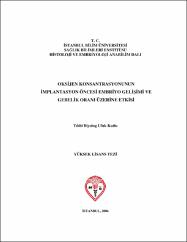Oksijen konsantrasyonunun implantasyon öncesi embriyo gelişimi ve gebelik oranı üzerine etkisi
Before implantation of oxygen concentration effects on embryo development and pregnancy rates
Künye
Kutlu, Ufuk. (2006). Oksijen Konsantrasyonunun İmplantasyon Öncesi Embriyo Gelişimi Ve Gebelik Oranı Üzerine Etkisi. Yayımlanmamış yüksek lisans tezi. İstanbul : İstanbul Bilim Üniversitesi, Sağlık Bilimleri Enstitüsü.Özet
Fertilize oosit disi genital kanallar içerisinde, %5 O2 konsantrasyonu etkisi altında
bulunmaktadır. Üremeye yardımcı tedavi yöntemlerinden biri olan mikroenjeksiyon
yönteminde embriyolar in vitro ortamda atmosferik oksijene (%20 konsantrasyonda) maruz kalabilmektedirler. Bu oranın olası olumsuz etkilerini ortadan kaldırabilmek amacıyla O2 kontrollü inkübatörler üretilmistir.
Bu çalısmada, çocuk sahibi olmak isteyen infertil çiftlerin tedaviye alınmasını
takiben mikroenjeksiyon islemi uygulandı. Elde edilen embriyolar randomize sekilde %20 ve %5 konsantrasyonda O2 içeren inkübatörlerde ayrı ayrı inkübe edildi.
Mikroenjeksiyondan sonraki birinci günde, üçüncü günde ve uygun vakalarda besinci
günde kontrol edilen embriyolar, skorlanarak fertilize oosit sayısı, üçüncü günde blastomer sayısı, üçüncü günde fragmantasyon, üçüncü gün iyi kalite embriyo sayısı, üçüncü gün kompaktlasma, besinci gün blastosist olusturma, besinci gün iyi kalite iç hücre kütlesi, besinci gün iyi kalite trofoblast, implantasyon ve gebelik oranları bakımından karsılastırıldı. Sonuçlar Mann-Whitney U testi ile degerlendirildi. Buna göre üçüncü günde kompaktlasma oranı, besinci gün blastosist olusturma oranı ve besinci günde iyi kalitede iç hücre kütlesine sahip olma oranı %5 O2 grubunda istatistiksel olarak anlamlı düzeyde daha yüksek bulundu (p<0.005). Besinci günde iyi kalitede iç hücre kütlesine sahip olma oranındaki anlamlılık ileri düzeydeydi. Diger parametrelerde fark gözlenmedi. implantasyon oranı %5 O2 grubunda daha yüksek olmasına karsın bu fark anlamlılık düzeyinde degildi.
Bu bulgular %5 O2 konsantrasyonu grubunda elde edilen embriyoların daha kaliteli
oldugunu, bu etkilerin özellikle üçüncü günden sonra morula ve blastosist asamalarında
belirgin oldugunu, fakat bu durumun embriyo ve gebelik elde etme oranlarını
etkilemedigini göstermistir. Yine de embriyo kalitelerindeki bu farkın uzun dönem
etkilerini inceleyen ileri arastırmaların yürütülmesi gerekmektedir. The zygote in the female reproductive tract of human is under 5% O2 concentration. On the other hand, the embryos of infertile couples formed via the microenjection method may be subjected to atmospheric oxygen level. Oxygen controlled incubators are derived in order to decrease the possible negative effects of it. The infertile couples with the desire of having a child were included to this study. The embryos obtained were assigned to 5% and 20% O2 concentrated incubators randomly way. The embryos were controlled on the first, third and in some cases fifth days fallowing the microinjection procedure and the results were recorded. Number of fertilized oocytes, number of blastomeres on the third day, fragmentation on the third day, number of good quality embryos on the third day, compaction on the third day, blastocyst formation on the fifth day, good quality ICM formation on the fifth day, good quality trophoblast formation on the fifth day, implantation and pregnancy rates were compared according to Mann-Whitney U test. Compaction rate in the third day, blastocyst formation rate in the fifth day and good quality ICM formation in the fifth day were statistically significantly higher in 5% O2 concentration group (p<0.005). This significance was high for good quality ICM formation on the fifth day. There was no difference for other parameters. The implantation rate was slightly higher in the 5% O2 group, but this difference was not statistically significant. Those findings show that the embryos obtained in 5% O2 concentration group had better qualities, being significant especially in the morula and blastocyst stages, but this did not have any effect on the pregnancy and implantation outcomes. However further studies should be designed in order to investigate the long term effects of this difference in the
qualities.


















